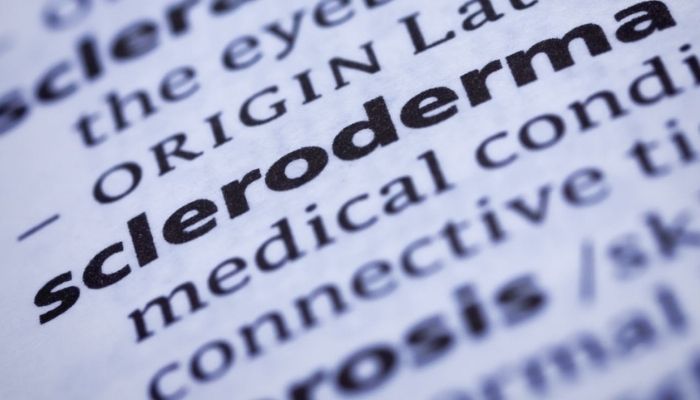|
For those of you new to our website and wanting to know a little more about Scleroderma, we hope this article gives you what you are looking for. If you want to ask questions from others on the same path, please don't hesitate to reach out via our FB pages. Scleroderma is a chronic disease that affects the skin and connective tissue, the tissue that supports and holds organs together, and is also found in the joints. The hallmark of scleroderma is thick and hardened skin caused by excessive production of collagen, a protein that is the main component of scar tissue. This scar tissue can accumulate in and damage organs, including the heart and blood vessels, and the lungs, stomach, and kidneys. Females are about four times more likely to develop scleroderma than males. Disease onset typically occurs between ages 35 and 50, though people of all ages can be affected. Causes Scleroderma is an autoimmune disease, meaning it is caused by an overactive immune system that mistakenly attacks the body’s own tissues. The resulting excessive inflammation damages the skin and affected organs. It is a complex condition, and the underlying disease process is not well understood. It is thought that the disease results from a combination of genetic and environmental factors. Scleroderma is not contagious, infectious, or cancerous. Symptoms Symptoms of scleroderma vary among patients, and can range from very mild to life-threatening depending on which parts of the body are affected and the extent of organ involvement. A mild case can become serious if not treated properly. Characteristic symptoms, besides patches of thick and hardened skin, include contractures when skin stiffens over joints, skin ulcers (sores), calcinosis — when lumps of calcium form under the skin — and Raynaud’s phenomenon, in which the fingers and toes feel numb, prickly, or frigid in response to cold temperatures or emotional distress. Manifestations affecting internal organs include damage to muscle and bone tissue, shortness of breath, an abnormal heart rhythm, a burning sensation in the chest (heartburn), difficulty swallowing, blurred vision. A scleroderma renal crisis is possible in some systemic scleroderma (mentioned below) patients. This renal, or kidney, crisis is a serious disorder characterized by a sudden onset of high blood pressure, progressive kidney failure, hypertensive encephalopathy (brain dysfunction or damage due to high blood pressure), and/or microangiopathic hemolytic anemia, or anemia due to the red blood cells being sheared (ripped apart) as they pass through small blood vessels. Diagnosis
As no single test is able to diagnose scleroderma, multiple assessments may be needed to exclude other disorders to reach a definitive diagnosis. These include physical exams, as well as biopsies to check for characteristic signs of the disease, blood tests to measure the production of antibodies against the body’s healthy tissue, and assessments of lung and heart function. Types of scleroderma This disease is broadly classified as either localized scleroderma or systemic scleroderma. The main difference between the two is the degree of internal organ involvement. People with localized scleroderma, the most common form in children, tend to have symptoms affecting the skin only, although it also can spread to tissues underneath the skin, such as muscle and bone. People with the systemic form are more likely to have internal organ involvement and damage. Both localized and systemic scleroderma can be further divided into subtypes, based on factors like the patterns and areas of skin affected. Treatment Although scleroderma has no cure, several treatments help to make the condition more manageable. Corticosteroids and other therapies that suppress the activity of the immune system can help to manage inflammation, and anti-fibrotic agents work to block the formation of excess scar tissue. In particular, Actemra (tocilizumab), known as RoActemra in Europe, is approved in the U.S. to slow lung function decline in adults with scleroderma-associated interstitial lung disease. It works by blocking a pro-inflammatory protein called interleukin-6, which plays a major role in several conditions. Patients also may need treatments that specifically address symptoms resulting from damage to particular organs. Physiotherapy also can help to improve the quality of life of people with this disease. Possible coexisting conditions People with scleroderma can be at risk for developing comorbidities or other conditions, such as Sjogren’s syndrome, erythromelalgia, fibromyalgia, and systemic lupus erythematosus. Last updated: May 13, 2021 *** Scleroderma News is strictly a news and information website about the disease. It does not provide medical advice, diagnosis or treatment. This content is not intended to be a substitute for professional medical advice, diagnosis, or treatment. Always seek the advice of your physician or other qualified health provider with any questions you may have regarding a medical condition. Never disregard professional medical advice or delay in seeking it because of something you have read on this website. Comments are closed.
|
AuthorScleroderma Queensland Support Group Archives
July 2024
Categories
All
|
Scleroderma Association of Queensland
©Scleroderma Association of Queensland. All rights reserved. Website by Grey and Grey.

